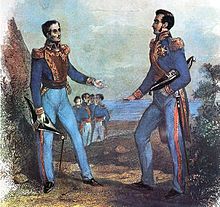Libertadores
[1] They were largely local-born men of European descent (criollos), in most cases part of the bourgeoisie and with military training in the motherland, who were influenced by liberalism and led colonial subjects in their struggle for independence against the metropole.
[15] Sporadically, the term has also been applied to other figures such as José Bonifacio (known as the "patriarch for independence"), Maria Leopoldina de Austria, and Joaquim Gonçalves Ledo.
[16] Emilio Aguinaldo, the first Filipino President and Generalissimo who liberated the Philippines from the Spanish Empire in 1898, is widely recognized as "El Libertador de la Patria" (The Liberator of the Homeland) [17] [18] The flags of Venezuela, Colombia and Ecuador follow Francisco de Miranda's design of 1806.
In what today is part of Mexico, Guatemala, El Salvador, Honduras, Nicaragua and Costa Rica, Agustín de Iturbide, a military leader revolted against the Viceroyalty of New Spain, founded an independent Mexican Empire where he ascended as Emperor Agustín I.
Also, the most prestigious international club football competition in South America is named the Copa Libertadores in their honour.


